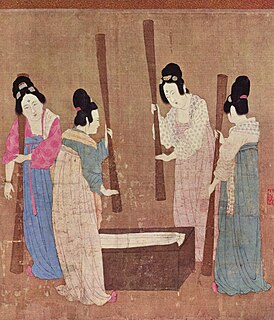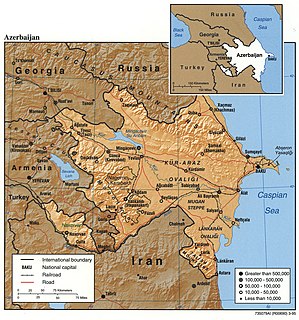
Silk is a natural protein fiber, some forms of which can be woven into textiles. The protein fiber of silk is composed mainly of fibroin and is produced by certain insect larvae to form cocoons. The best-known silk is obtained from the cocoons of the larvae of the mulberry silkworm Bombyx mori reared in captivity (sericulture). The shimmering appearance of silk is due to the triangular prism-like structure of the silk fibre, which allows silk cloth to refract incoming light at different angles, thus producing different colors.

Sericulture, or silk farming, is the cultivation of silkworms to produce silk. Although there are several commercial species of silkworms, Bombyx mori is the most widely used and intensively studied silkworm. Silk was believed to have first been produced in China as early as the Neolithic Period. Sericulture has become an important cottage industry in countries such as Brazil, China, France, India, Italy, Japan, Korea, and Russia. Today, China and India are the two main producers, with more than 60% of the world's annual production.

Shaki is a city in northwestern Azerbaijan, in the rayon of the same name.

Agdash is a rayon in central Azerbaijan. The Agdash rayon consists of Leki settlement and 72 villages. This rayon has a favorable economic and geographic location. Turyan River and Kura River along South-West border extend through the territory of the rayon. Upper Shirvan Channel also crosses Agdash region. This area is surrounded by Tugay forests along Kura river bank, and Turyanchay State Preservation to the north.

Goychay is a region of Azerbaijan located in the central part of the country. The region is famous for its pomegranate growing industry, and for its pomegranate festival.

Hajigabul is one of the districts of Azerbaijan established in 1990 by the decision of the Supreme Council of the Republic. The district is bordered by Absheron, Gobustan, Shamaxı, Aghsu, Kurdamir, Sabirabad, Salyan, and Shirvan city.

Shamakhi or Shamakhy is a rayon of the Republic of Azerbaijan. Its administrative center is Shamakhi city.
The Russo-Persian Wars or Russo-Iranian Wars were a series of conflicts between 1651 and 1828, concerning Persia (Iran) and the Russian Empire. Russia and Persia fought these wars over disputed governance of territories and countries in the Caucasus. The main territories disputed were Aran (Azerbaijan), Georgia and Armenia, as well as much of Dagestan – generally referred to as Transcaucasia – and considered part of the Safavid Iran prior to the Russo-Persian Wars. Over the course of the five Russo-Persian Wars, the governance of these regions transferred between the two empires. Between the Second and Third Russo-Persian Wars, there was an interbellum period in which a number of treaties were drawn up between the Russian and the Persian Empires, as well as between both parties and the Ottoman Empire. Ottoman interest in these territories further complicated the wars, with both sides forming alliances with the Ottoman Empire at different points throughout the wars. Following the Treaty of Turkmenchay, which concluded the Fifth Russo-Persian War, Persia ceded much of its Transcaucasian territory to the Russian Empire.

Shamakhi is the capital of the Shamakhi Rayon of Azerbaijan. The city's estimated population as of 2010 was 31,704. It is famous for its traditional dancers, the Shamakhi Dancers, and also for perhaps giving its name to the Soumak rugs.

Tomioka Silk Mill is Japan's oldest modern model silk reeling factory, established in 1872 by the government to introduce modern machine silk reeling from France and spread its technology in Japan. The factory is designated by the government as a National Historic Site and all its buildings are preserved in very good condition. It is located in the city of Tomioka, Gunma prefecture, Japan, about 100 km northwest of Tokyo.

The production of silk originated in China in the Neolithic period. Silk production remained confined to China until the Silk Road opened at some point during the later half of the 1st millennium BC, though China maintained its virtual monopoly over silk production for another thousand years.
The primary crops produced in Azerbaijan are agricultural cash crops, grapes, cotton, tobacco, citrus fruits, and vegetables. The first three crops account for over half of all production, and the last two together account for an additional 30 percent. Livestock, dairy products, and wine and liquors are also important farm products.

Historically, cotton production in Azerbaijan has been crucial to the national economy, accounting for approximately 25% of agricultural revenue. It occurs mainly in the area west of the Caspian Sea. Historical records supported by archaeological excavations have established cotton growing in Azerbaijan to the 5th and 6th centuries AD. During the Soviet era, it was termed as the nation's "white gold". Since the fall of the Soviet Union and independence, cotton has significantly declined in output, given that oil and grains are more profitable for Azeri farmers.

Azerbaijani wine is produced in several regions throughout Azerbaijan. Prior to 20th century communist rule, Azerbaijan had a thriving wine industry that dated back to the second millennium BC. Azerbaijan's long history of wine production was rediscovered at archaeological digs of settlements in Kültəpə, Qarabağlar and Galajig where archaeologists discovered stone fermentation and storage vessels that included residue and grape seeds dating back to the second millennium BC. The Ancient Greeks were well aware of wine production in the area by at least the 7th century BC according to Herodotus. Later Strabo would comment in the 1st century BC about an Azerbaijani wine known as Albania. Arabic historians and geographers—most notably Abu'l-Fida, Al-Masudi, Ibn Hawqal and Al-Muqaddasi - described the extensive viticulture around Ganja and Barda that was taking place even after Islamic conquest of the area.

Azerbaijani traditional clothing is the traditional attire of the Azerbaijani people. It is closely connected to its history, religious culture and national identity. Costumes and dress are of great importance in Azerbaijani culture. Azerbaijani style is visible in ornaments of costume with artistic embroideries in weaving and knitting.

Shaki-Zagatala economic region is one of the 10 economic regions of Azerbaijan. It borders Dagestan, Russia, to the north, Georgia to the west, and Ganja-Gazakh, Aran, Mountainous Shirvan, Guba-Khachmaz economic regions to the south and east. Region consists of Balakan, Zagatala, Gakh, Shaki, Oghuz and Qabala administrative districts. Other than the 6 districts, there are also 6 cities, 8 settlements, 336 villages and 181 municipalities in the economic region. Municipal elections are held by voting.
The Azerbaijan is a country with very favorable natural conditions and rich natural resources. Snowy peaks, high mountains, foothill fertile soils, wide plains, Lowest Land Points Below Ocean Level are the main landscape forms of republic. This complex landscape structure has caused the variety in natural conditions - climate, soil-vegetation, and water resources. This, in turn, led to the uneven distribution of population and farms on the territory, and the specialization of production on different types.

The Mountainous Shirvan economic Region is one of many economic areas in Azerbaijan. The region includes the Agsu, Ismaili, Gobustan, and the Shemakha regional administrative districts. This region consists of four cities, four districts and eight settlements consisting of 106 territorial districts, and 275 settlements. The region is located in the Southeast of the Greater Caucasus Mountain Range. The area (6,130 km²) comprises 7% of Azerbaijan. As of 2015 the population was 304,000 people, or 3.2% of Azerbaijan's total population. The population density of the economic region is 50 people/km².
The fruit sector in Azerbaijan is a developing industry. The sector covered 171,600 ha. of land in 2016. Grape, apple, orange, pear and pomegranate are one of the major crops in fruit production in Azerbaijan.
Industrialization in the Russian Empire enabled the development of the industrial sector of the economy, which allowed to increase labor productivity and partially provided the economy with industrial products. Industrialization in the Russian Empire was a reaction to the industrialization process in Western Europe countries.













